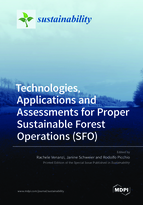Technologies, Applications and Assessments for Proper Sustainable Forest Operations (SFO)
A special issue of Sustainability (ISSN 2071-1050). This special issue belongs to the section "Sustainable Forestry".
Deadline for manuscript submissions: closed (31 December 2021) | Viewed by 30091
Special Issue Editors
Interests: sustainable forest operations; reduced impact logging; QBS-ar index; sustainable forest management; forest mechanisation
Special Issues, Collections and Topics in MDPI journals
Interests: Ecosystem services, decision support systems, life cycle assessment; sustainability impact assessment; methods and tools for climate adapted strategic and operational planning of forest management; unpredictable use of wood; carbon costs, -storage & sequestration
Interests: forest utilizations; logging activities; reduced impact logging; sustainable forest management; forest restoration systems
Special Issues, Collections and Topics in MDPI journals
Special Issue Information
Dear Colleagues,
This Special Issue focuses on the "Technologies, Applications, and Assessments for Proper Sustainable Forest Operations (SFO)". One of the main topics will be to promote knowledge for future relations between forest logging, environmental protection, and management of forests in order to provide timber at reasonable costs and other ecosystem services, such as recreation and conservation as well as biodiversity. Only efficient planning and management of forest operations and the implementation of sustainable supply chains will offer high social and environmental benefits and provide various ecosystem services in the long term. These aspects can be guaranteed only through sustainable forest management in synergy with SFO, tools essential for proper environmental protection, and they are mandatory in order to maintain forests and their multiple functions. In particular, forest operations are interesting but delicate issues to be analyzed and evaluated in order to achieve real sustainability.
Authors are invited to contribute to this Special Issue with original papers covering the following subjects:
- Sustainability in forest operations;
- Impact assessment due to forest logging and management;
- Innovative forest harvesting systems, technologies, and techniques
- The role and potential of precision forestry (robotics, LIDAR, etc.) for improving management;
- Sustainability of wood supply chains;
- Environmentally friendly forest operations and reduced impact logging (RIL);
- How can forest operations be adjusted to preserve the levels of biodiversity necessary to keep forests healthy and productive?
We also encourage studies from all fields, including experimental studies, monitoring approaches, and models, on silviculture and logging activities to contribute to this Special Issue in order to promote knowledge and future strategies for effective and efficient SFO.
Dr. Rachele Venanzi
Dr. Janine Schweier
Prof. Dr. Rodolfo Picchio
Guest Editors
Manuscript Submission Information
Manuscripts should be submitted online at www.mdpi.com by registering and logging in to this website. Once you are registered, click here to go to the submission form. Manuscripts can be submitted until the deadline. All submissions that pass pre-check are peer-reviewed. Accepted papers will be published continuously in the journal (as soon as accepted) and will be listed together on the special issue website. Research articles, review articles as well as short communications are invited. For planned papers, a title and short abstract (about 100 words) can be sent to the Editorial Office for announcement on this website.
Submitted manuscripts should not have been published previously, nor be under consideration for publication elsewhere (except conference proceedings papers). All manuscripts are thoroughly refereed through a single-blind peer-review process. A guide for authors and other relevant information for submission of manuscripts is available on the Instructions for Authors page. Sustainability is an international peer-reviewed open access semimonthly journal published by MDPI.
Please visit the Instructions for Authors page before submitting a manuscript. The Article Processing Charge (APC) for publication in this open access journal is 2400 CHF (Swiss Francs). Submitted papers should be well formatted and use good English. Authors may use MDPI's English editing service prior to publication or during author revisions.
Keywords
- Sustainability
- Forest management
- Forest Operations
- Reduced-impact logging (RIL) techniques
- Low impact logging
- Environmental impact assessment
- Ecological indicator
- Ecosystem services
- Silviculture








